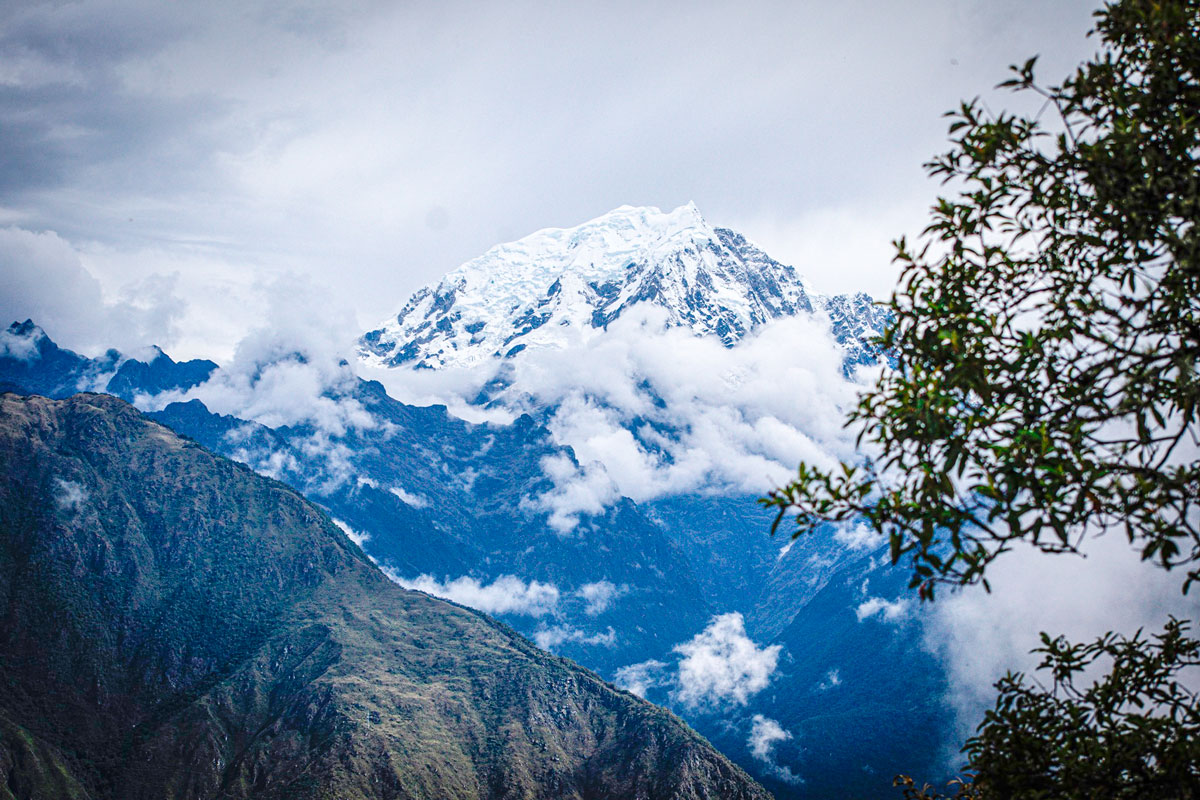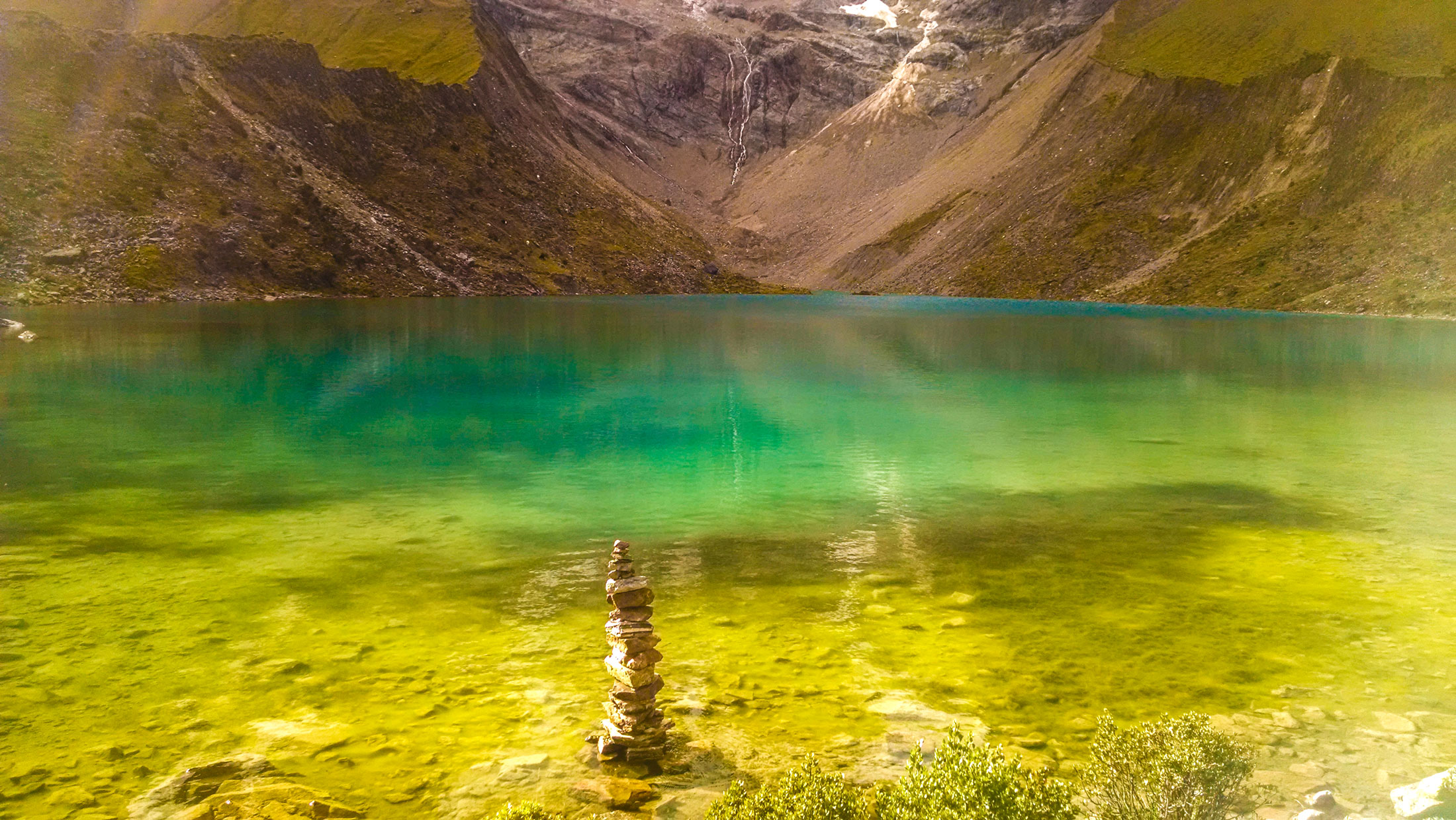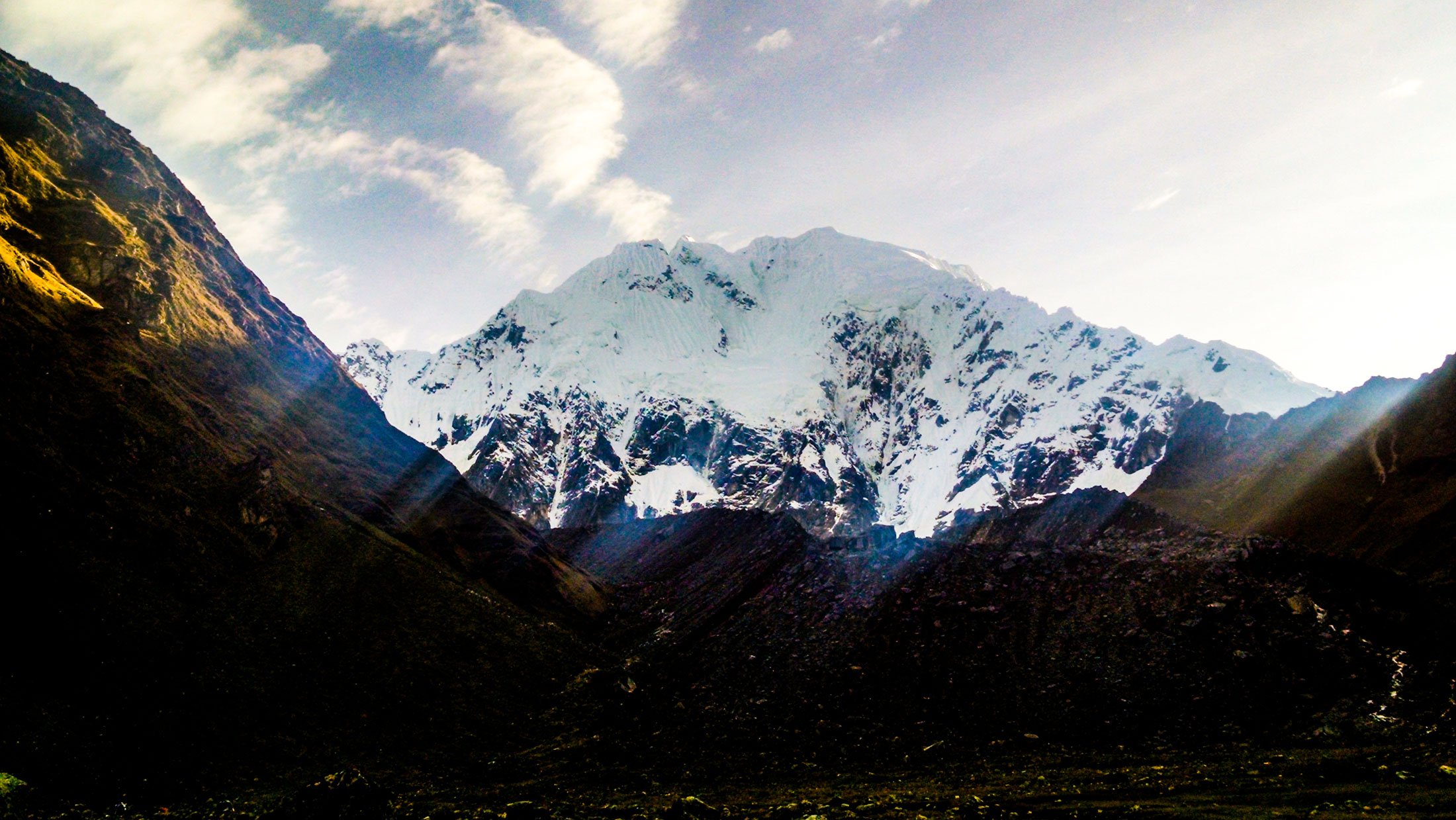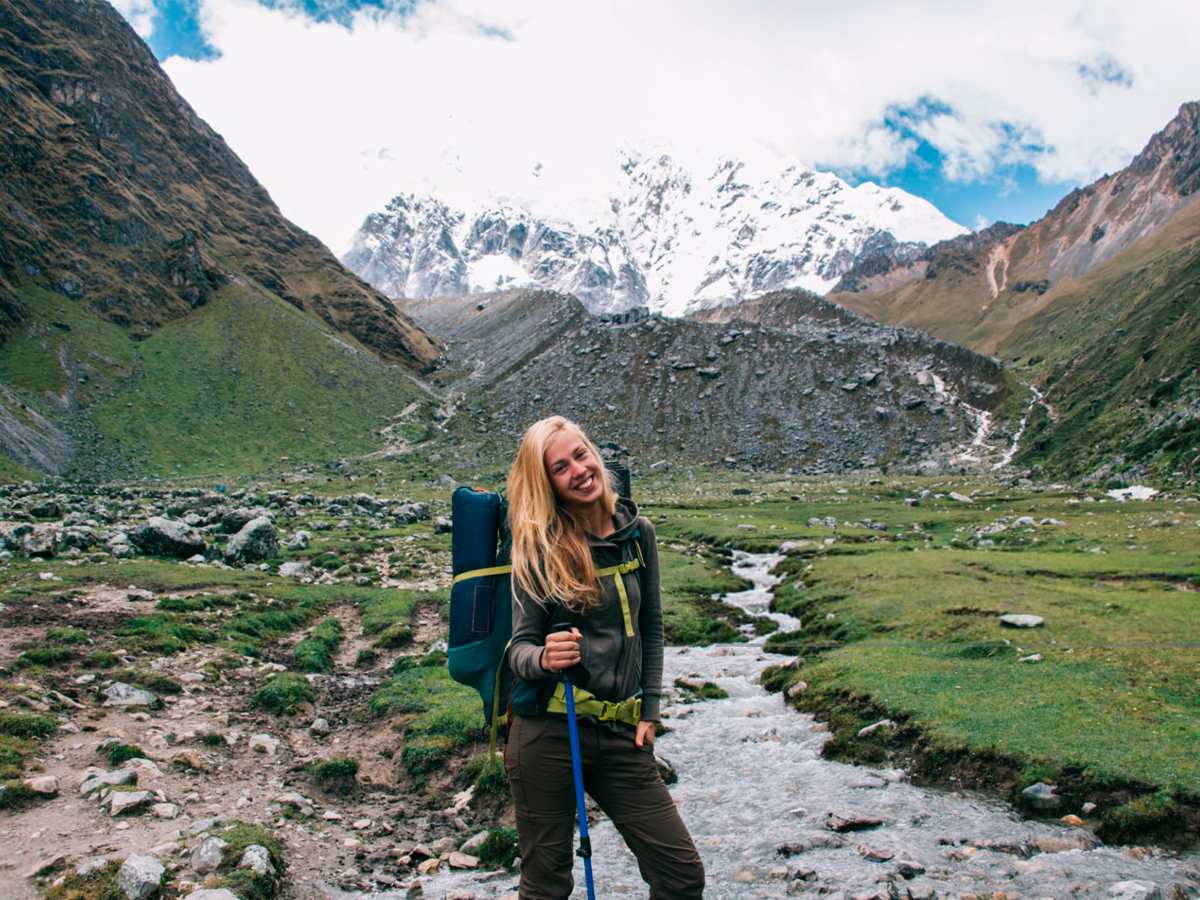
Salcantay (Salkantay Mountain), Sallqantay in Quechua is the highest peak of the Willkapampa mountain range, part of the Peruvian Andes. It is located in the Cusco Region, about 60 km (37 mi) west-northwest of the city of Cusco. It is the 38th highest peak in the Andes, and the twelfth highest in Peru. However, as a range highpoint in deeply incised terrain, it is the second most topographically prominent peak in the country, after Huascarán.
The Salkantay Trek offers a more natural beauty, unlike the ancient ruins. It passes high mountains and jungle, all in very desolate areas. The trek usually starts in the town of Mollepata or Soraypampa in the Apurímac valley northwest of Cusco. It can be reached in the early morning by bus. Then you will visit the Humantay Mountain lagoon. The first night on this walk is cold, it is important that you are prepared for that. The camp is located next to the snow Salkantay Peak. On a clear night, you will see a sky full of stars. Having a good quality sleeping bag is essential if you want a good night's sleep.
Salkantay in Quechua means "wild mountain". According to some authors the name of this mountain Salkantay is a contraction that comes from (Salqa means wild or wild) and Antay means to produce avalanches. The name of Apu, which in the Quechua language comes to mean lord, is usually defined in front of the great mountains that means something sacred above the valleys.

The Humantay lagoon is located in the province of Anta, Cusco.
To get to this lagoon we must take a mobility that takes us to the charming village of Mollepata, where it is recommended take breakfast and do the necessary shopping since it is the last point where you can find a store of products. From Mollepata you must take another mobility to the town of Soraypampa in a stretch of about 2 hours to then start the trek up to the lagoon, the road is the same to go to the snowy Salkantay taking a deviation halfway to reach the lagoon after hours of walking approximately. The road is somewhat complicated due to the altitude, remember that you will be over 4,000 meters above sea level, so it is recommended to stay in the city of Cusco for at least 1 day to acclimatize; but we promise that when you arrive at the lagoon at the foot of the Humantay mountain you will not regret it and you will realize that the trip was worth it.

The weather in Salkantay Peru is very sunny during the day, but cold at night. The temperature falls below 0 ° C at night during the months of June to September. In the season from December to March it is very rainy reason why the path is closed in those months.
To get to Salkantay you will necessarily have to get to the city of Cusco, either from the capital city Lima of Peru, or some other department.
It is necessary to go with a guide to well direct the way for your adventure tours of Salkantay treks.
The buses from Cusco to Mollepata depart very early and pass through Limatambo. We suggest you visit the Tarahuasi fortress. From the road you can see the Apurímac River and part of its impressive canyon. Keep in mind that the area is cold and reaches an altitude close to 5,000 MASL.
Already in Mollepata, for being 2,803 MASL it allows to climb gradually towards the Salkantay. On the way there are flocks of camelids. After climbing a step of height it is possible to have an impressive pyramidal view of the snowy Salkantay. From the same Mollepata it takes two days to go down to Huayllabamba and connect with the second day of the Inca Trail. When making this tour to Salkantay we will get to know Mollepata, where the famous Salkantay mountain is located.
Various treks involve routes from Salkantay Mountain: one joins the Inca Trail at Huayllabamba, then proceeds as before on the main Trail through Wiñay Wayna to Machu Picchu. To get Salkantay, you have to start in Mollepata, north west of Cusco of Apurimac valley, Salkantay to Machu Picchu take five nights or three nights or seven nights. A seven-nights trek goes from Paucarcancha, an important camping site on the trek from Salkantay, to Huayllabamba, then on the traditional Inca Trail to Machu Picchu. Paucarcancha is a abandoned set of ruins on the descent from Pampacahuana, before the village of Huayllabamba on the main Inca Trail. Nearby there are some hot springs.

There are other route which approach the Inca Trails to Machu Picchu, such as Km 77, Chilca, up the Silque ravine in the Quente Valley, which is commonly called the Lago Ancascocha route. Then there is another access through the Millpo Valley in the Salkantay area. From Vilcabamba mountain range, one can reach Machu Picchu by hiking down fron Huancacalle to Chaullay by road, getting to Santa Teresa and walking to the Hydrolectric (Aobamba) train station. Then it's an three hour's walking by ride way to Aguas Calientes.
The classic Salkantay Trek to Machu Picchu 5 days is from Cusco to Mollepata - Challacancha, from there, you start to walk to Soraypampa camping and visit the Umantay Lake and Salkantay Mountain. Continue the trek to Salkantay Mountain (4550 m) and after descent to Colpapampa campsite. Next day the walking is moderate to Playa, appreciate the flora and fauna (orchird). On four day wake earlly and walk up to Llactapata Mountain, appreciate the Machu Picchu Mountain, then 3 hrs to Hydrolect and continue the trek to Machu Picchu.
The best time for the weather to do Salkantay treks is better during the months of June to September. So if you decide to travel between those months, we recommend you to bring warm clothes so you can prevent getting sick, where you can safely do your adventure tours of Salkantay treks.

As it is a 5 day journey, you will need a backpack of 30 liters or more, resistant to rain and with extra pockets to carry extra things.
The Salkantay Hike offers diverse landscapes with different climates so it is necessary that you go prepared for sunny days, rain, snow and humidity. We recommend you bring:
The memories of your adventure will be recorded forever in the memory of the camera and you can share them with your friends and family. To ensure the functioning of your equipment, do not forget to bring extra batteries and an additional memory card. The landscapes that you will find are one of the reasons to choose the way from Salkantay to Machu Picchu, so prepare that camera!
Also, it is very important that your backpack has your original passport and your original identity document to be able to identify you at the checkpoints. In case of being a student, the ISIC card will be useful for some discounts in the price of the tour and in some establishments in the city of Cusco.
Finally, bring some souvenirs of your country. Share your culture with your travel companions and the people you meet along the way!
It is known as the Inca Trail 4 days, a walk that departs from the Sacred Valley of the Incas and has Machu Picchu as its final destination. The other Inca route is the Short Inca Trail. This trail is starting from Km 104. you will visit the Chachabamba, Wiñaywayna, Intipata Inca sites.
The Salkantay Trek is an alternative hike to the classic Inca Trail, it consists of reaching Machu Picchu through snow-capped peaks, abundant vegetation, fauna, lagoons and a high-Andean landscape.
The Classic Salkantay Trek has a duration of 4 days / 3 nights or 5 days/ 4 nights.
Since the Classic Inca Trail last 4 days / 3 nights
Total Route: 65 km - 40.4 miles
Total Route: 43 km - 26.72 miles
The trek to Salkantay is considered high level.
Since the Inca trail is considered a moderate level trek.